
In the past decade there have been significant changes in the orthodontic marketplace including new technologies, more treatment options and a widening range in the quality of treatments provided. Two award-winning, nationally recognized orthodontists—Dr. Ross Segal and Dr. Monisha Iyer—provide insights that will help patients make the right choices in this rapidly changing environment.
Lately I’ve been seeing ads for products that look a lot like Invisalign. You order them online and get them in the mail. Do they work the same as what you would get from an orthodontist?
Those services, a form of teledentistry known as direct-to-consumer (DTC) orthodontics, are becoming more commonplace. That name is somewhat deceptive because in many cases there’s no orthodontist involved, and the experience is quite different from actual orthodontic treatment.
The process typically starts with the company mailing a kit to the patient, who attempts to take goopy impressions and selfies of their own teeth. The patient then mails the photos and impressions (if they worked) back to the company. Some companies offer patients the option of going to a nearby office where impressions or scans of their teeth are taken by a technician—usually not under the supervision of an orthodontist.
A few weeks later the company mails a series of aligners to the patient. Treatment consists of the patient wearing sets of aligners in sequence until they reach the final set.
These virtual treatments are different than the comprehensive orthodontic treatments we offer in a number of ways:
• Our in-person evaluations are performed by experienced orthodontists who are able to identify and resolve problems that could escape detection in a photo— problems that could adversely affect treatment. Unlike DTC companies, we work closely with your dentist to ensure that your overall dental health is fully supported during orthodontic treatment.
• Many of the factors that should be considered when planning orthodontic treatment are not visible to the naked eye (position of your roots, bone density, etc.). That’s why we use X-rays, 3D scans and when needed, advanced cone beam technology, to accurately assess your condition and develop treatment plans that are extremely precise.
• We go beyond merely straightening your teeth. We manage your bite to ensure that it is comfortable and functional. We also take your entire face into account, thus creating smiles that are more aesthetically pleasing.
• We don’t simply implement a static plan. We routinely monitor your progress throughout treatment, making adjustments along the way as needed to ensure excellent results.
• We offer a much wider set of orthodontic solutions than is available through teledentistry, which allows us to move any tooth in any direction. We can effectively treat all types of malocclusions (misalignments).
If I need braces, is there a way to avoid the molding material they use to take impressions of my teeth? It always makes me gag.
Perhaps one of the most appreciated developments in orthodontics has been the use of digital 3-D scanning. With a simple handheld wand, we are able to capture the information needed to create complete models of your teeth and gums. For patients, this 3D technology has eliminated the need for those goopy, gag-inducing impressions. Just as exciting is the ability for us to show patients their virtual results before treatment even begins. Digital scanning delivers superior precision too, providing a much clearer and more detailed representation of the patient. Orthodontists using this technology are able to treat more precisely and minimize length of treatment.
I read something online about orthodontists using cone beams, but the orthodontist I spoke with doesn’t use them. Are they important?
What you read was probably about cone beam computed tomography (CBCT) systems, which are capable of taking 3D X-rays. Yes, they are an important resource because the two-dimensional nature of traditional dental X-rays does not tell the whole story. For example, 2D X- rays provide limited information about the position of an impacted tooth—if they reveal it at all—and how surrounding teeth might be affected. CBCT equipment allows orthodontists to see teeth, tissue and bone in three dimensions. Consequently, they can better assess whether treatment is needed, what treatment is required and when it should begin.
Analyzing the bone structure surrounding the roots of the teeth is an important part of treatment planning. When traditional X-rays can’t supply the data we need, we use CBCT technology to provide a clearer picture. This enables us to align not only the teeth but the roots as well, so we’re able to achieve superior cosmetic results.
Although the benefits of CBCT systems are compelling, they are not yet widely used by orthodontists. The equipment can cost upwards of $100,000, which deters some practices from investing in the technology.
Does treatment still usually take two years or more?
Average treatment times have declined over the past decade, and durations of two years are less common than before. Treatment times depend on a variety of factors including the current position of the teeth, characteristics of surrounding bone, type of orthodontic treatment being applied and—in the case of Invisalign—whether the patients wear their aligners regularly.
Practices employing advanced acceleration technologies and methods are able to give patients the option to significantly reduce their treatment times. Here are the two we’ve found to be most effective: Propel involves a chair-side procedure that’s conducted every 10 to 12 weeks, as needed. We use the Propel Excellerator to stimulate remodeling of bone surrounding the teeth, which accelerates their movement. Capable of reducing treatment times by 30 to 50 percent— sometimes even more—it’s the fastest non-surgical acceleration technique on the market today. Using Propel, we routinely complete cases in less than 12 months that might otherwise take two years or more.
Propel can be used in conjunction with braces or Invisalign.
Insignia is an orthodontic system that features indirect bonding and custom-designed brackets. Orthodontists with the necessary skills and experience can use Insignia’s 3D software to plan and manage treatments that not only produce outstanding results, but are so efficient they’ve been shown to reduce treatment times by over 30 percent.
In 2016, Invisalign modified its treatment guidelines to allow for more frequent aligner changes; every seven days. By utilizing acceleration technology, orthodontists can increase that frequency to every three to four days. They can achieve the same excellent results, in less time, without compromising quality of care.
SEGAL AND IYER ORTHODONTICS
501 Route 73 S., Suite 202 | Marlton | (856) 810-1006 | SegalAndIyer.com
Published (and copyrighted) in Suburban Family Magazine, Volume 9, Issue 12 (February 2019).
For more info on Suburban Family Magazine, click here.
For information about advertising in Suburban Family Magazine, click here.
To find out where to pick up your copy of Suburban Family Magazine, click here.




